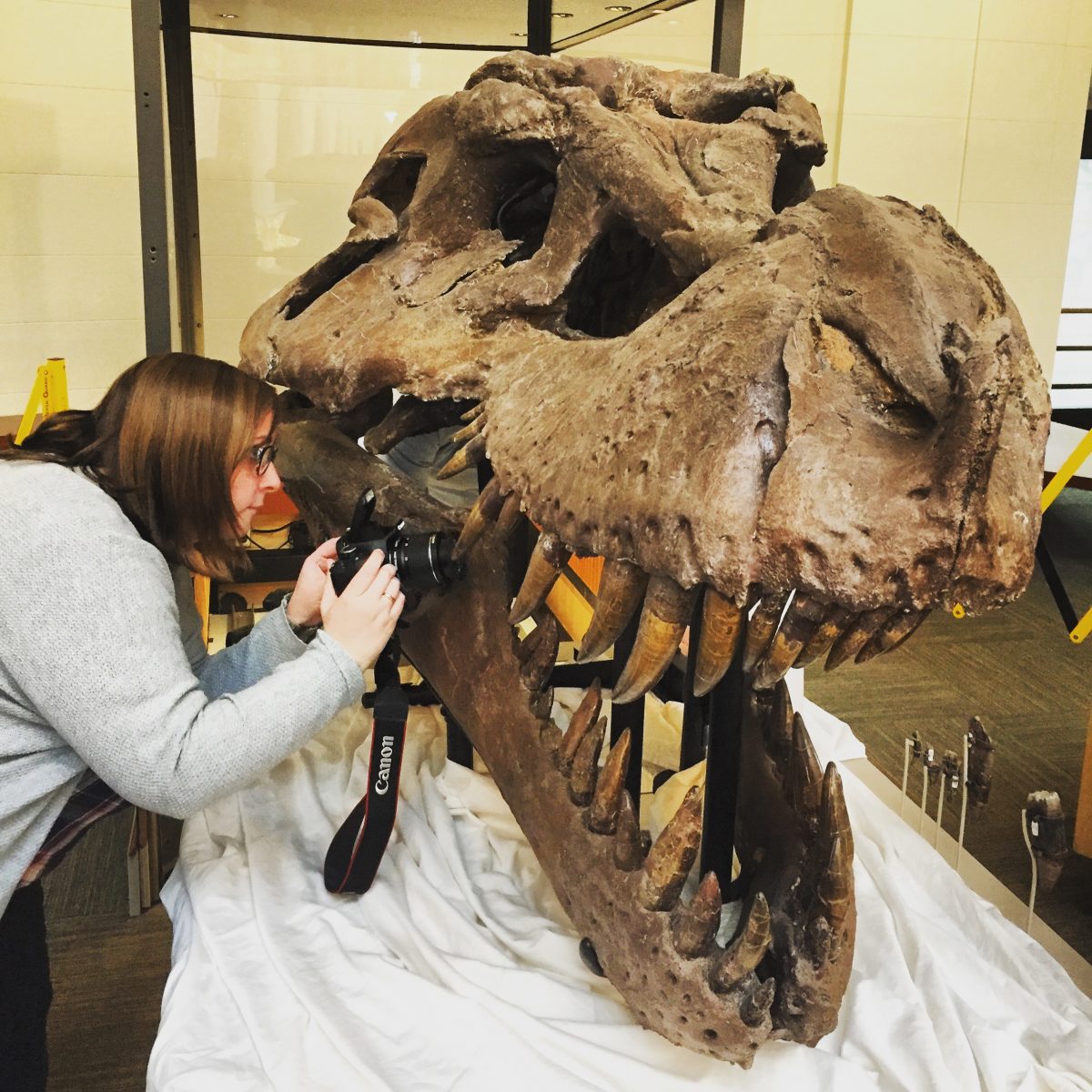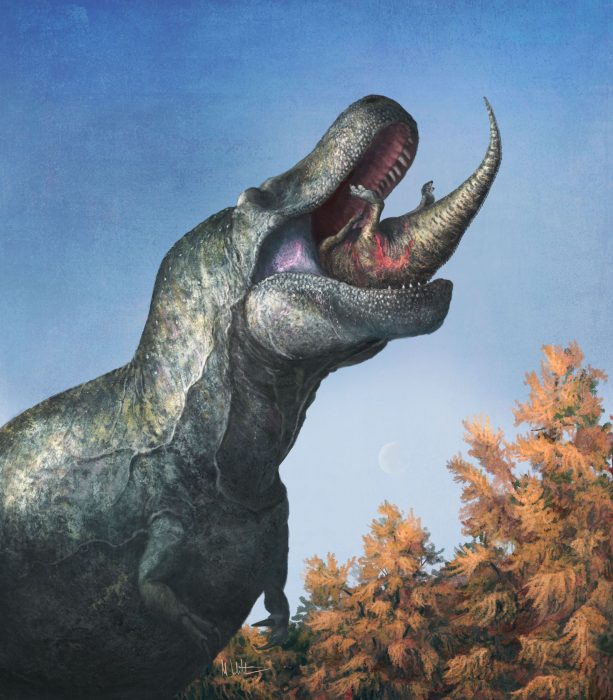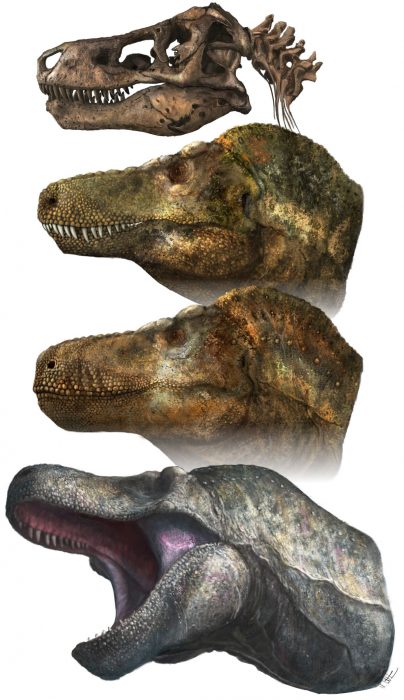
Dr. Kirstin Brink examines the teeth from a fossilized T-Rex skull named "Sue".
Fascinating Manitobans: U of M professor recognized for breakthrough research
Dr. Kirstin Brink from the department of Earth Sciences in the Clayton H. Riddell Faculty of Environment, Earth, and Resources has been named one of Manitoba’s top 100 ‘most fascinating individuals’ in 2023
Dr. Kirstin Brink and an international team of paleontologists have released a study that suggests predatory dinosaurs, such as the Tyrannosaurus Rex, did not have permanently exposed teeth as depicted in films like Jurassic Park. Instead, their research indicates that these dinosaurs had scaly lizard-like lips sealing their mouths.
Due to Dr. Brink’s involvement with this study, Ace Burpee (Host, Ace Burpee Show, 103.1 Virgin Radio) has recognized her as one of the top 100 most fascinating Manitobans in 2023. The full list can be found here.
Dr. Brink was recently interviewed about this accomplishment and discussed the inspiration behind her research.
She started her career with the University of Manitoba at the beginning of 2020 with a focus on vertebrate paleontology. Her interests include the evolution and development of teeth and bones.
“This is the only scientific field where you can ask the questions of ‘how’ and ‘why’ the planet is the way it is,” states Brink. “I always found it interesting how paleontologists study evolutionary life on Earth. When we look back in deep time, we are able to question why the planet became the way it is, and how we can project that information into the future. Can we predict what might come?”
When asked about her career and line of research, Dr. Brink was enthusiastic to share what makes it most exciting.

A juvenile Edmontosaurus disappears into the enormous, lipped mouth of the Tyrannosaurus. Illustration created by and in the copyright of Mark P. Witton.
“Being a paleontologist attracts the interest of younger generations, especially when you work on dinosaurs,” Dr. Brink said. “Often, dinosaurs are the first introduction to science, and it encourages curiosity when students start asking qualifying questions.”
The study of dinosaur lips has been an ongoing project throughout Dr. Brink’s academic career.
“The hypothesis behind this research came from looking at the media in 1993,” says Dr. Brink. “At the time, some other grad students and I were questioning the depiction of dinosaur teeth in Jurassic Park. We started by gathering data from a student who was working on Komodo Dragon teeth. I was researching the internal structure of the mouth and used some of the gathered information to figure out how the outer layer, the enamel, needed to stay wet with saliva in order to function. Most species have lips to help with that.”
Dr. Brink and her team investigated the evolutionary line of other similar reptiles with exposed teeth, like the crocodile, to find more evidence.
“Crocodiles live in water to keep their teeth wet, and they have a lot of scratches,” states Dr. Brink. “Dinosaurs have very beautiful teeth that are not scratched on outer surfaces. Instead, there are marks found on the inner surfaces, which would come from rubbing against food inside the mouth. This was a piece of evidence that their teeth had to be protected.”
Dr. Brink and the team were satisfied with their findings, stating that it was an expected outcome.
“Looking back, early iterations just looked and felt wrong. We had a hunch it should not be exposed, and everything made sense when we put it all together.”

T-Rex skull and head reconstruction. Illustration created by and in the copyright of Mark P. Witton.
When looking to the future, Dr. Brink is excited to start on her next big research undertaking. Her interests now lie in tooth pathologies, also understood as the development of teeth.
“There are lots of developmental things that happen in human teeth, which have been documented thanks to dentistry,” says Dr. Brink. “There is similar development that occurs with reptile teeth, but it hasn’t been researched or documented much before.”
Dr. Kirstin Brink is also the Adjunct Curator of Fossil Vertebrates at the Canadian Fossil Discovery Centre in Morden, MB. Find out more about her research and other members of her lab here.
This story has been featured in headlines globally, including Globe and Mail, Wall Street Journal, New York Times, CBC, National Geographic, CNN, CBS and NBC, and more.
Full team list:
- Kirstin Brink: Assistant Professor of Palaeontology in the Department of Earth Sciences at the University of Manitoba; Adjunct Curator of Vertebrates at the Canadian Fossil Discovery Centre
- Thomas Cullen: Assistant Professor of Paleobiology in the Department of Geosciences at Auburn University, Scientific Affiliate at the Field Museum of Natural History
- Derek Larson: Collections Manager & Researcher, Palaeontology at the Royal BC Museum
- Mark P. Witton: University of Portsmouth






